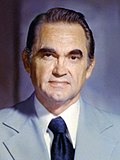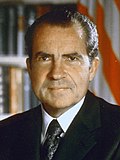| |||||||||||||||||||||||||||||||||||||
All 10 Alabama electoral votes to the Electoral College | |||||||||||||||||||||||||||||||||||||
|---|---|---|---|---|---|---|---|---|---|---|---|---|---|---|---|---|---|---|---|---|---|---|---|---|---|---|---|---|---|---|---|---|---|---|---|---|---|
| |||||||||||||||||||||||||||||||||||||
 County Results
| |||||||||||||||||||||||||||||||||||||
| |||||||||||||||||||||||||||||||||||||
| Elections in Alabama |
|---|
 |
|
|
The 1968 United States presidential election in Alabama was held on November 5, 1968. In Alabama, voters voted for electors individually instead of as a slate, as in the other 49 states.
The 1960s had seen Alabama as the epicenter of the Civil Rights Movement, highlighted by numerous bombings by the Ku Klux Klan in "Bombingham",[1] Birmingham police commissioner Eugene "Bull" Connor's use of attack dogs against civil rights protesters, attacks on the Freedom Riders and Selma to Montgomery marchers, and first-term Governor George Wallace's "stand in the door" against the desegregation of the University of Alabama.[2] The state Democratic Party, which had remained closed to African-Americans two decades after Smith v. Allwright outlawed the white primary,[3] had by a five-to-one margin refused to pledge its 1964 electors to incumbent President Lyndon B. Johnson,[4] and no attempt was made to challenge this Wallace-sponsored Democratic slate with one loyal to the national party.[5] Despite sponsoring the state Democratic slate, in the 1964 general election Wallace would back Republican nominee Barry Goldwater,[6] who won almost seventy percent of Alabama's ballots against the state Democratic electors, for his opposition to the Civil Rights Act of 1964.
George Wallace would build a third party candidacy with his right-wing populist American Independent Party during the following two years, campaigning on opposition to desegregation, race riots, and the counterculture. However, with the state Democratic Party still refusing to integrate,[3] the national party made efforts to place its own electors on the Alabama ballot in 1967.[7] As expected, Wallace won the state Democratic primary in May, and was listed as the “Democratic” candidate on the Alabama ballot.[8] National Democratic nominee Hubert Humphrey was able,[9] unlike Harry S. Truman and outgoing President Johnson, to gain ballot access on a fusion of the "Alabama Independent Democrat" and National Democratic lines.[10] 78% of white voters supported Wallace, 16% supported Nixon, and 4% supported Humphrey.[11][12][13]
Cite error: There are <ref group=lower-alpha> tags or {{efn}} templates on this page, but the references will not show without a {{reflist|group=lower-alpha}} template or {{notelist}} template (see the help page).
- ^ Bullock, Charles S.; Gaddie, Ronald Keith (October 22, 2014). The Triumph of Voting Rights in the South. University of Oklahoma Press. pp. 41–42. ISBN 978-0806185309.
- ^ Bullock, Charles S.; Gaddie, Ronald Keith (October 22, 2014). The Triumph of Voting Rights in the South. University of Oklahoma Press. pp. 41–42. ISBN 978-0806185309..
- ^ a b Walton, Hanes (1972). Black Political Parties: An Historical and Political Analysis. New York Free Press. p. 149.
- ^ McDannald, Alexander Hopkins (1965). Yearbook of the Encyclopedia Americana (Report). p. 63.
- ^ Cleghorn, Reece (August 13, 1964). "Who Speaks for Mississippi". The Reporter. pp. 31–33.
- ^ Grimes, Roy (October 11, 1964). "Look Away, Look Away…". The Victoria Advocate. p. 4A.
- ^ Bennett, James (January 1, 1968). "State Politics Will Heat Up". Birmingham Post-Herald. p. 2.
- ^ "Alabama in Bewildering Political State". The Columbus Ledger. Columbus, Georgia. May 11, 1968. p. A-2.
- ^ Bennett, James (August 26, 1968). "Most State Delegates To Sign Loyalty Oath". Birmingham Post-Herald. pp. 1, 2.
- ^ "1968 Presidential General Election Results — Alabama". Dave Leip's Atlas of U.S. Presidential Elections. Retrieved September 2, 2014.
- ^ Black & Black 1992, p. 147.
- ^ Black & Black 1992, p. 295.
- ^ Black & Black 1992, p. 335.



